Non-Destructive Multi-Feature Analysis of a Historic Wooden Floor
Abstract
:1. Introduction
2. Materials and Methods
2.1. General Description of the Historical Building (Merced Convent)
2.2. Acoustic Emission Analysis
2.3. Elastic Wave Analysis
2.4. Visual Analysis
- Knots; these are singularities of the wood stemming from the presence of branches of the tree (Figure 11b). All knots were measured, including their diameter and their position on the beam. It was determined if they constituted through knots, edge knots or grouped knots.
- Splits; these are cracks in the radial and axial direction, occurring in wood when the resistance values are exceeded due to growth stresses or drying among other reasons (Figure 11c). Their length and position on the beam were determined. It was also determined whether they were non-passing splits, i.e., passing through the end or not through the end.
- Wanes; this defect appears in solid timber when, on one of its edges, part of the original curvature of the trunk is visible due to the absence of wood (Figure 11d). Wanes were classified according to their length and their relative dimension.
2.5. Modelling
3. Results
3.1. Detection of Active Xylophages by Means of the Acoustic Emission Method
3.1.1. Laboratory Test with Inoculated Reticulitermes Termites
3.1.2. AE Measured In Situ on the Wooden Floor
3.2. Acoustic Wave Analysis
3.3. Visual Analysis
3.4. Numerical Analysis Results
4. Discussion and Conclusions
Author Contributions
Funding
Data Availability Statement
Acknowledgments
Conflicts of Interest
References
- Faherty, K.F.; Williamson, T.G. Wood Engineering and Construction. Handbook; McGraw-Hill: Oxford, UK, 1998. [Google Scholar]
- Palma, P.; Steiger, R. Structural health monitoring of timber structures—Review of available methods and case studies. Constr. Build. Mater. 2020, 248, 118528. [Google Scholar] [CrossRef]
- Ghaly, A.; Edwards, S. Termite damage to buildings: Nature of attacks and preventive construction methods. Am. J. Eng. Appl. Sci. 2011, 4, 187–200. [Google Scholar] [CrossRef]
- Llana, D.F.; Iñiguez-Gonzalez, G.; Díez, M.R.; Arriaga, F. Nondestructive testing used on timber in Spain: A literature review. Maderas-Cienc. Tecnol. 2020, 22, 133–156. [Google Scholar] [CrossRef] [Green Version]
- French, J.R.J.; Ahmed, B.M.; Thorpe, J. Deciding the age of subterranean termite damage in buildings. In Proceedings of the 41st Annual International Research Group of Wood Protection Conference, Biarritz, France, 9–13 May 2010. [Google Scholar]
- Ahmed, B.M.; French, J.R.J. An overview of termite control methods in Australia and their link to aspects of termite biology and ecology. Pak. Entomol. 2008, 30, 101–118. [Google Scholar]
- Cavaleri, T.; Pelosi, C.; Ricci, M.; Laureti, S.; Romano, F.P.; Caliri, C.; Ventura, B.; De Blasi, S.; Gargano, M. IR Reflectography, Pulse-Compression Thermography, MA-XRF, and Radiography: A Full-Thickness Study of a 16th-Century Panel Painting Copy of Raphael. J. Imaging 2022, 8, 150. [Google Scholar] [CrossRef]
- Laureti, S.; Colantonio, C.; Burrascano, P.; Melis, M.; Calabrò, G.; Malekmohammadi, H.; Sfarra, S.; Ricci, M.; Pelosi, C. Development of integrated innovative techniques for paintings examination: The case studies of The Resurrection of Christ attributed to Andrea Mantegna and the Crucifixion of Viterbo attributed to Michelangelo’s workshop. J. Cult. Herit. 2019, 40, 1–16. [Google Scholar] [CrossRef]
- Tavakolian, P.; Shokouhi, E.B.; Sfarra, S.; Gargiulo, G.; Mandelis, A. Non-destructive imaging of ancient marquetries using active thermography and photothermal coherence tomography. J. Cult. Herit. 2020, 46, 159–164. [Google Scholar] [CrossRef]
- Gavrilov, D.; Maev, R.G.; Almond, D.P. A review of imaging methods in analysis of works of art: Thermographic imaging method in art analysis. Can. J. Phys. 2014, 92, 341–364. [Google Scholar] [CrossRef]
- Fiocco, G.; Ceccarelli, S.; Albano, M.; Rovetta, T.; Malagodi, M.; Orazi, N.; Paoloni, S. Structural feature investigation of wooden artifacts through imaging techniques: A step forward in the preservation of historical musical instruments. J. Phys. Conf. Ser. 2022, 2204, 012033. [Google Scholar] [CrossRef]
- Grosse, C.U.; Ohtsu, M. Acoustic Emission Testing; Springer: Berlin, Germany, 2008. [Google Scholar]
- Mizutani, Y. Practical Acoustic Emission Testing; Springer: Tokyo, Japan, 2016. [Google Scholar]
- Ono, K. Application of acoustic emission for structure diagnosis. Diagnostyka 2011, 2, 3–18. [Google Scholar]
- Martínez-Jequier, J.; Gallego, A.; Suarez, E.; Juanes, F.J.; Valea, A. Real-time damage mechanisms assessment in CFRP samples via acoustic emission Lamb wave modal analysis. Compos. Pt. B-Eng. 2015, 68, 317–326. [Google Scholar] [CrossRef]
- Rescalvo, F.J.; Valverde-Palacios, I.; Suarez, E.; Roldán, A.; Gallego, A. Monitoring of carbon fiber-reinforced old timber beams via strain and multiresonant acoustic emission sensors. Sensors 2018, 18, 1224. [Google Scholar] [CrossRef] [PubMed]
- Sagasta, F.; Zitto, M.E.; Piotrkowski, R.; Benavent-Climent, A.; Suarez, E.; Gallego, A. Acoustic emission energy b-value for local damage evaluation in reinforced concrete structures subjected to seismic loadings. Mech. Syst. Signal Process. 2018, 102, 262–277. [Google Scholar] [CrossRef]
- Rescalvo, F.J.; Aguilar-Aguilera, A.; Suarez, E.; Valverde-Palacios, I.; Gallego, A. Acoustic emission during wood-CFRP adhesion tests. Int. J. Adhes. Adhes. 2018, 87, 79–90. [Google Scholar] [CrossRef]
- Gallego, A.; Benavent-Climent, A.; Suarez, E. Concrete-Galvanized Steel Pull-Out Bond Assessed by Acoustic Emission. J. Mater. Civ. Eng. 2015, 28, 04015109. [Google Scholar] [CrossRef]
- Nasir, V.; Ayanleye, S.; Kazemirad, S.; Sassani, F.; Adamopoulos, S. Acoustic emission monitoring of wood materials and timber structures: A critical review. Constr. Build. Mater. 2022, 350, 128877. [Google Scholar] [CrossRef]
- Fujii, Y.; Noguchi, M.; Imamura, Y.; Tokoro, M. Using acoustic emission monitoring to detect termite activity in wood. For. Prod. J. 1990, 40, 34–36. [Google Scholar]
- Gonzalez de la Rosa, J.J.; Puntonet, C.G.; Lloret, I. An application of the independent component analysis to monitor acoustic emission signals generated by termite activity in wood. Measurement 2005, 7, 63–76. [Google Scholar] [CrossRef]
- Robbins, W.P.; Mueller, R.K.; Schaal, T.; Ebeling, T. Characteristics of acoustic emission signals generated by termite activity in wood. In Proceedings of the IEEE 1991 Ultrasonics Symposium, Orlando, FL, USA, 9–11 December 1991; pp. 1047–1051. [Google Scholar]
- Indrayani, Y. Feeding activities of the dry-wood termite Cryptotermes domesticus (Haviland) under various relative humidity and temperature conditions using acoustic emission monitoring. Jpn. J. Environ. Entomol. Zool. 2003, 14, 205–212. [Google Scholar]
- Indrayani, Y.; Yoshimura, T.; Yanase, Y.; Fujii, Y.; Imamura, Y. Evaluation of the temperature and relative humidity preferences of the western dry-wood termite Incisitermes minor (Hagen) using acoustic emission (AE) monitoring. J. Wood Sci. 2007, 53, 76–79. [Google Scholar] [CrossRef]
- González de la Rosa, J.J.; Lloret, I.; Moreno, A.; Puntonet, C.G.; Górriz, J.M. Wavelets and wavelet packets applied to detect and characterize transient alarm signals from termites. Measurement 2006, 39, 553–564. [Google Scholar] [CrossRef]
- González de la Rosa, J.J.; Agüera Pérez, A.; Palomares Salas, J.C.; Sierra Fernández, J.M. A novel measurement method for transient detection based in wavelets entropy and the spectral kurtosis: An application to vibrations and acoustic emission signals from termite activity. Measurement 2015, 68, 58–69. [Google Scholar] [CrossRef]
- Oliver-Villanueva, J.; Abian-Perez, M. Advanced wireless sensors for termite detection in wood constructions. Wood Sci. Technol. 2013, 47, 269–280. [Google Scholar] [CrossRef]
- Xue, S.; Zhou, H.; Liu, X.; Wang, W. Prediction of compression strength of wood usually used in ancient timber buildings by using resistograph and screw withdrawal tests. Wood Res. 2019, 64, 249–260. [Google Scholar]
- Franco, D.; Nunes, L.; Saporiti, J.; Brito, J. Timber in buildings: Estimation of some properties using Pilodyn® and Resistograph®. In Proceedings of the 12th International Conference on Durability of Building Materials and Components, Porto, Portugal, 12–15 April 2011. [Google Scholar]
- Lenzen, F.; Kim, K.I.; Schäfer, H.; Nair, R.; Meister, S.; Becker, F.; Garbe, C.S.; Theobalt, C. Denoising Strategies for Time-of-Flight Data. In Time-of-Flight and Depth Imaging. Sensors, Algorithms, and Applications; Springer: Berlin, Germany, 2013; pp. 25–45. [Google Scholar]
- Chauhan, S.; Sethy, A. Differences in dynamic modulus of elasticity determined by three vibration methods and their relationship with static modulus of elasticity. Maderas Cienc. Tecnol. 2016, 18, 373–382. [Google Scholar] [CrossRef]
- Rescalvo, F.J.; Ripoll, M.A.; Suarez, E.; Gallego, A. Effect of location, clone, and measurement season on the propagation velocity of poplar trees using the Akaike information criterion for arrival time determination. Materials 2019, 12, 356. [Google Scholar] [CrossRef] [Green Version]
- Li, X.; Shang, X.; Morales-Esteban, A.; Wang, Z. Identifying P phase arrival of weak events: The Akaike Information Criterion picking application based on the Empirical Mode Decomposition. Comput. Geosci. 2017, 100, 57–66. [Google Scholar] [CrossRef]
- Mborah, C.; Ge, M. Enhancing manual P-phase arrival detection and automatic onset time picking in a noisy microseismic data in underground mines. Int. J. Min. Sci. Technol. 2018, 28, 691–699. [Google Scholar] [CrossRef]
- Kolassa, S. Combining exponential smoothing forecasts using Akaike weights. Int. J. Forecast. 2011, 27, 238–251. [Google Scholar] [CrossRef]
- Fonseca, C.; D’Ayala, D.; Fernandez Cabo, J.L.; Díez, R. Numerical modelling of historic vaulted timber structures. Adv. Mater. Res. 2013, 778, 517–525. [Google Scholar]
- D’Amico, B.; Kermani, A.; Zhang, H.; Pugnale, A.; Colabella, S.; Pone, S. Timber gridshells: Numerical simulation, design and construction of a full scale structure. Structures 2015, 3, 227–235. [Google Scholar] [CrossRef]
- Wang, X.; Ross, R.J.; Carter, P. Acoustic evaluation of wood quality in standing trees. Part I. Acoustic wave behavior. Wood Fiber Sci. 2007, 39, 28–38. [Google Scholar]
- EN 384:2016+A1:2018; Structural Timber. Determination of Characteristic Values of Mechanical Properties and Density. Comite Europeen de Normalisation: Brussels, Belgium, 2018.
- UNE 56544:2022; Clasificación Visual de la Madera Aserrada para USO Estructural. Madera de Coníferas. AENOR: Madrid, Spain, 2022.
- EN 338:2016; Structural Timber. Strength Classes. Comite Europeen de Normalisation: Brussels, Belgium, 2016.
- EN 1995-1-2:2004/AC:2009; Eurocode 5: Design of Timber Structures—Part 1-2: General—Structural Fire Design. Comite Europeen de Normalisation: Brussels, Belgium, 2020.
- EN 1995-1-1:2004+A1; Eurocode 5: Design of Timber Structures—Part 1-1: General—Common Rules and Rules for Buildings. Comite Europeen de Normalisation: Brussels, Belgium, 2008.
- EN 1990:2002/A1:2005/AC:2010; Eurocode: Basis of Structural Design. Comite Europeen de Normalisation: Brussels, Belgium, 2020.
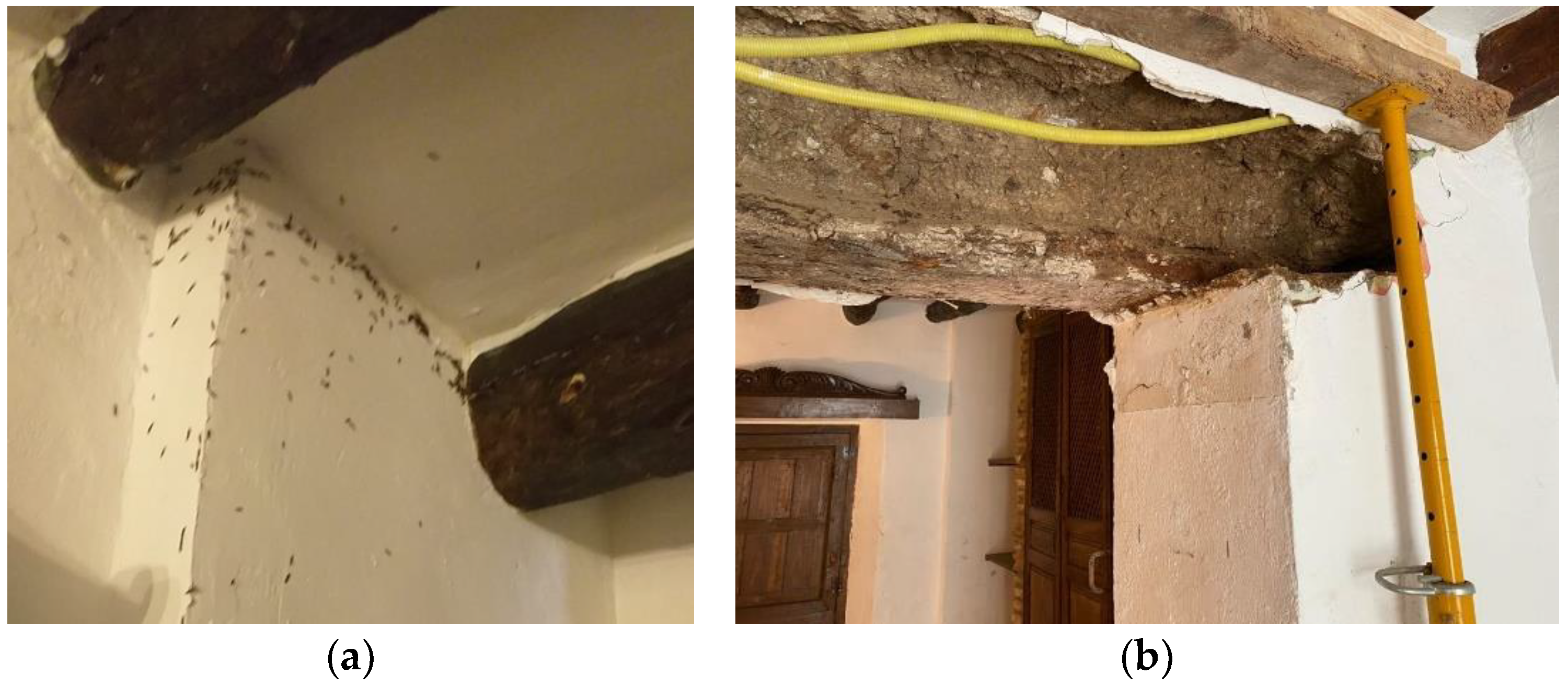
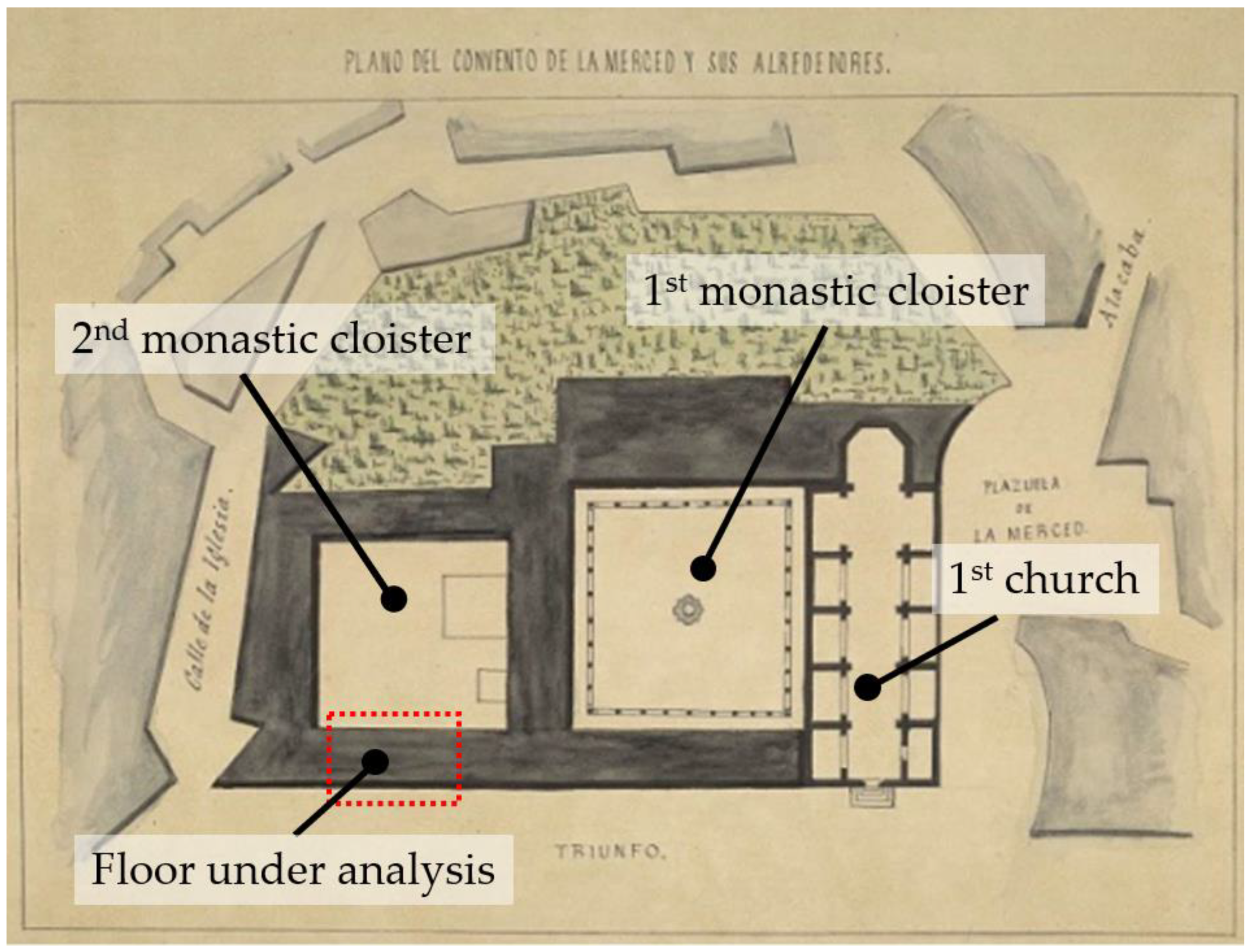
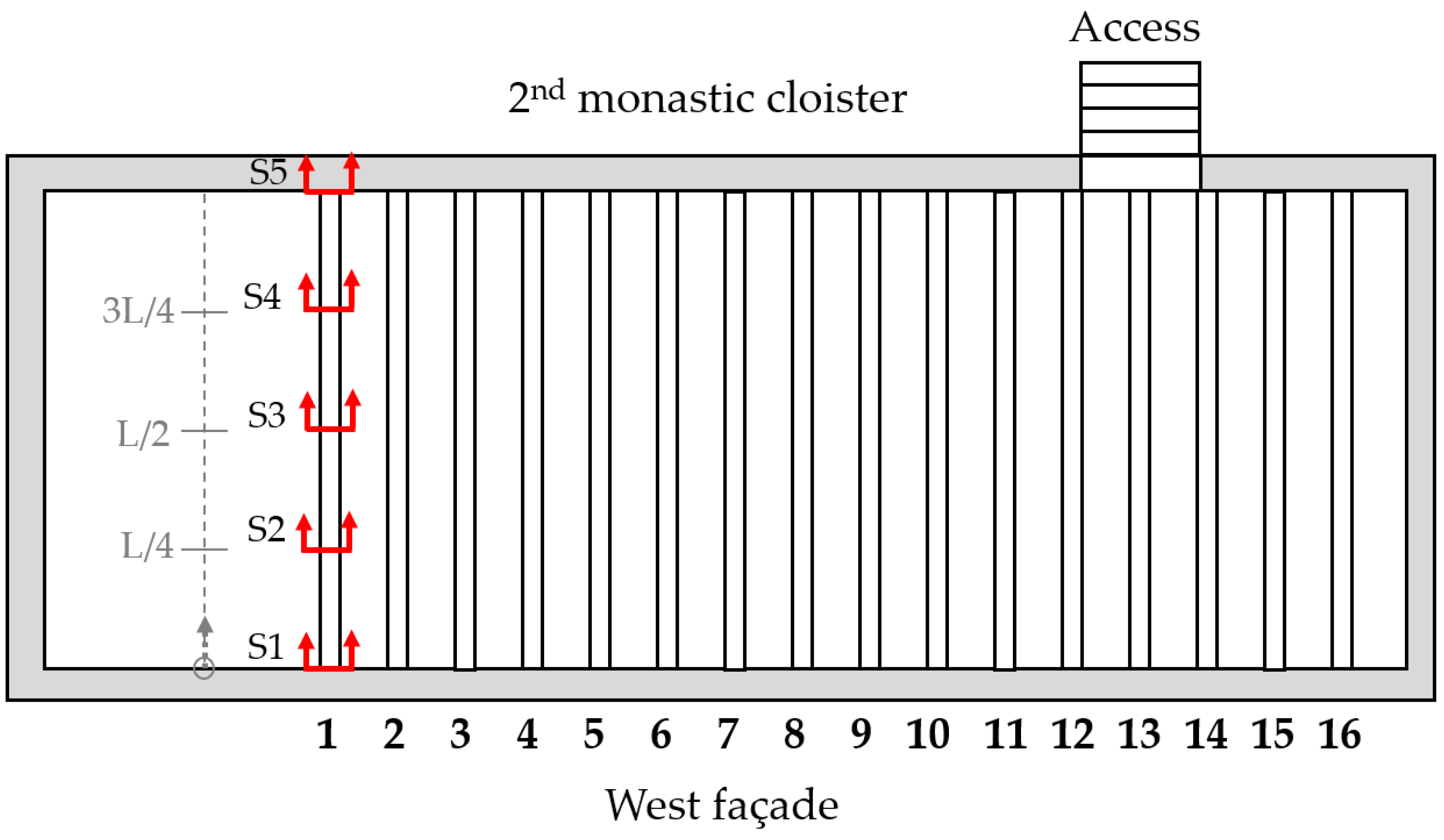
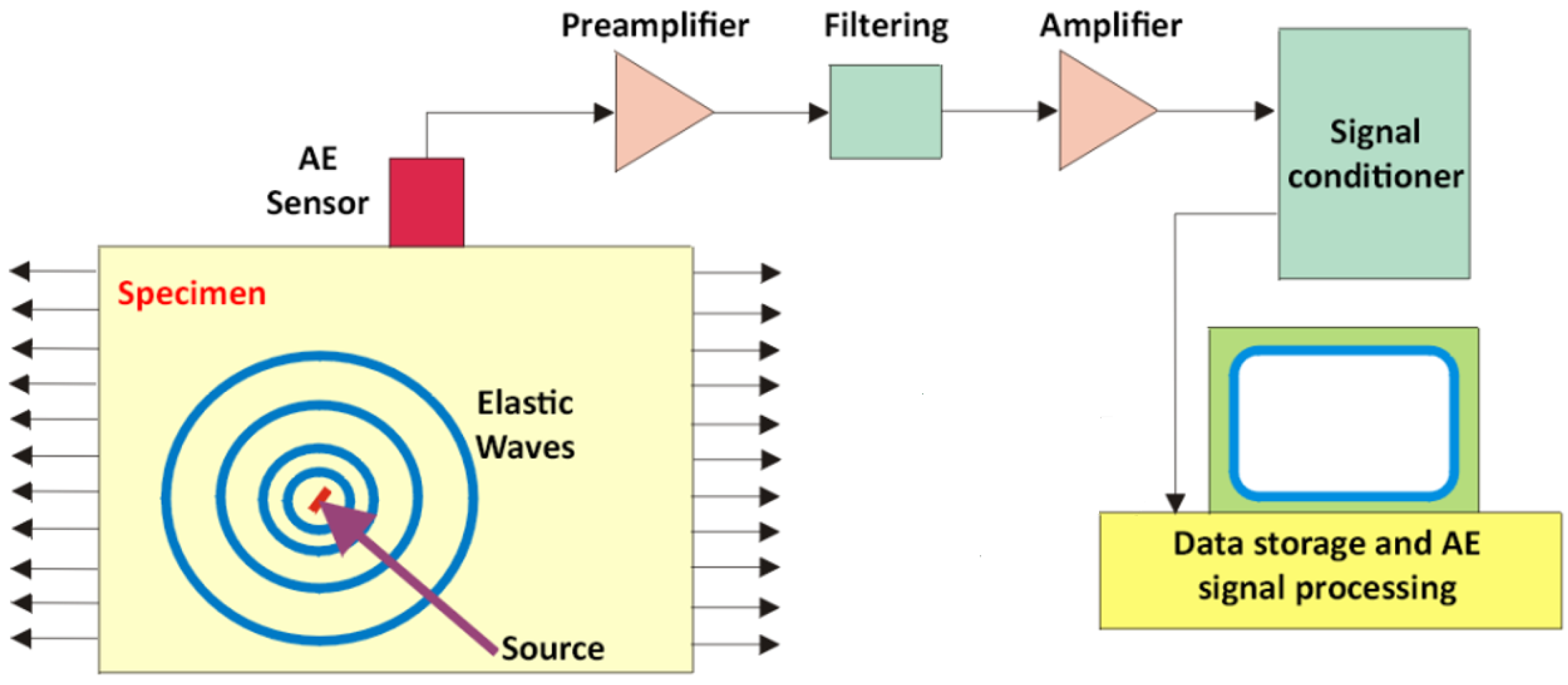
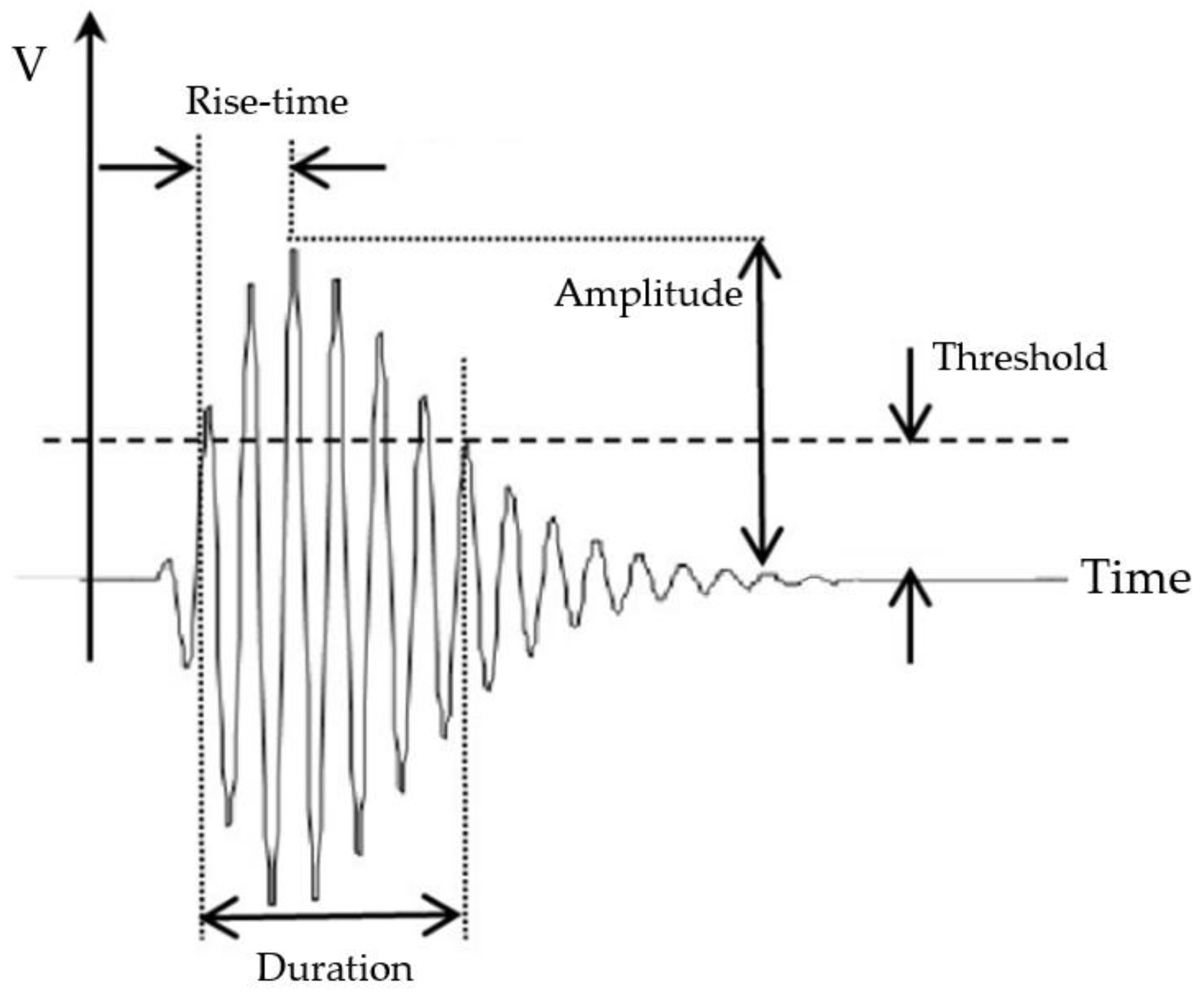
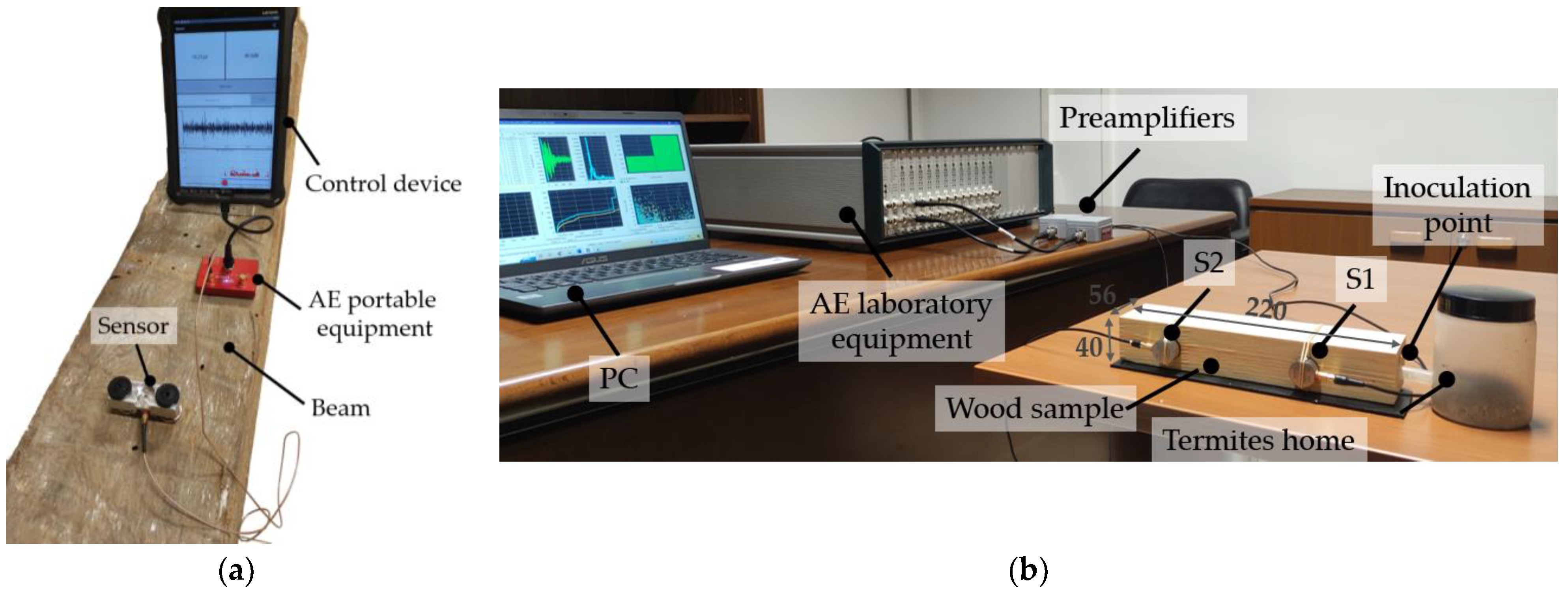
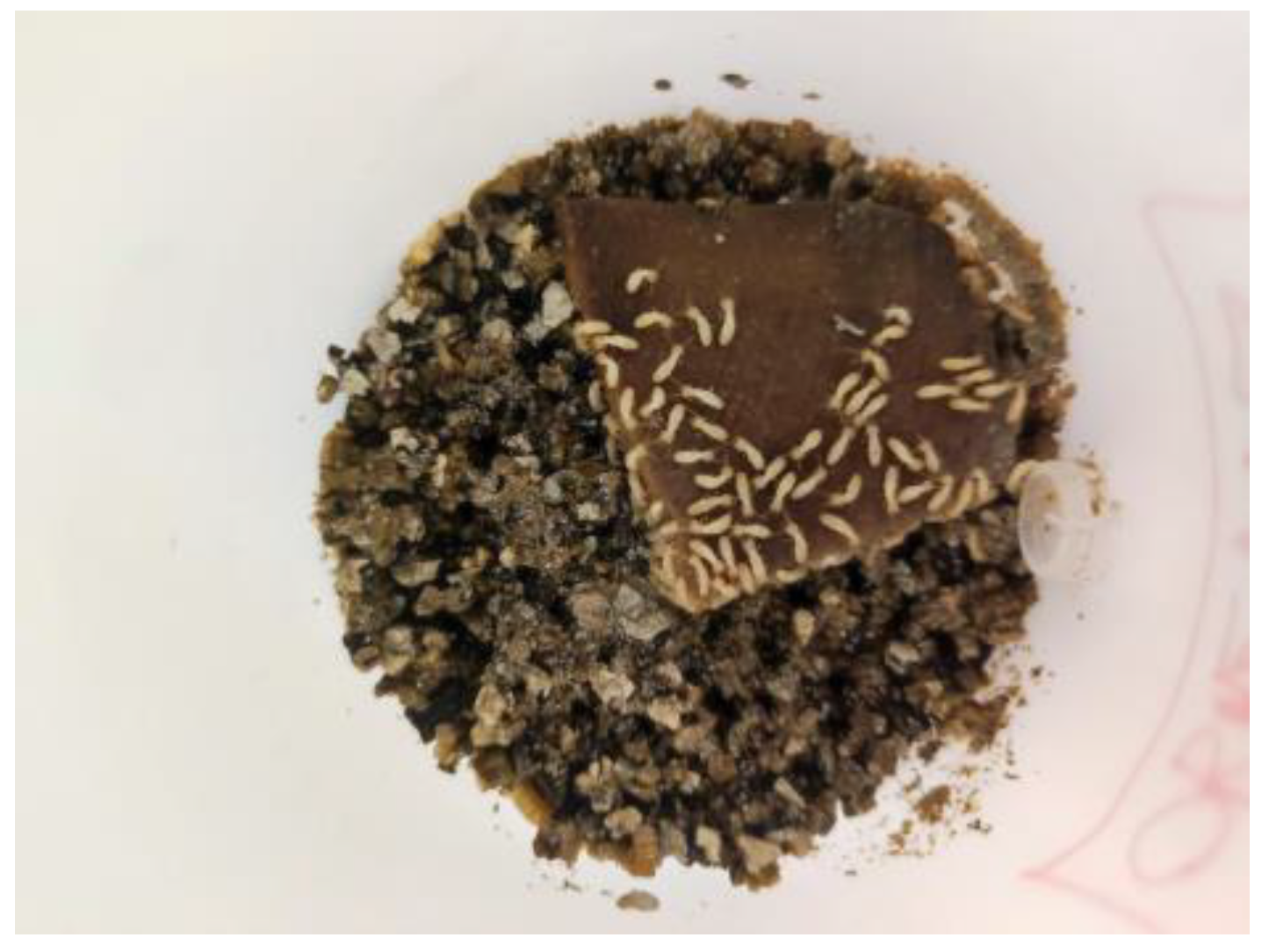
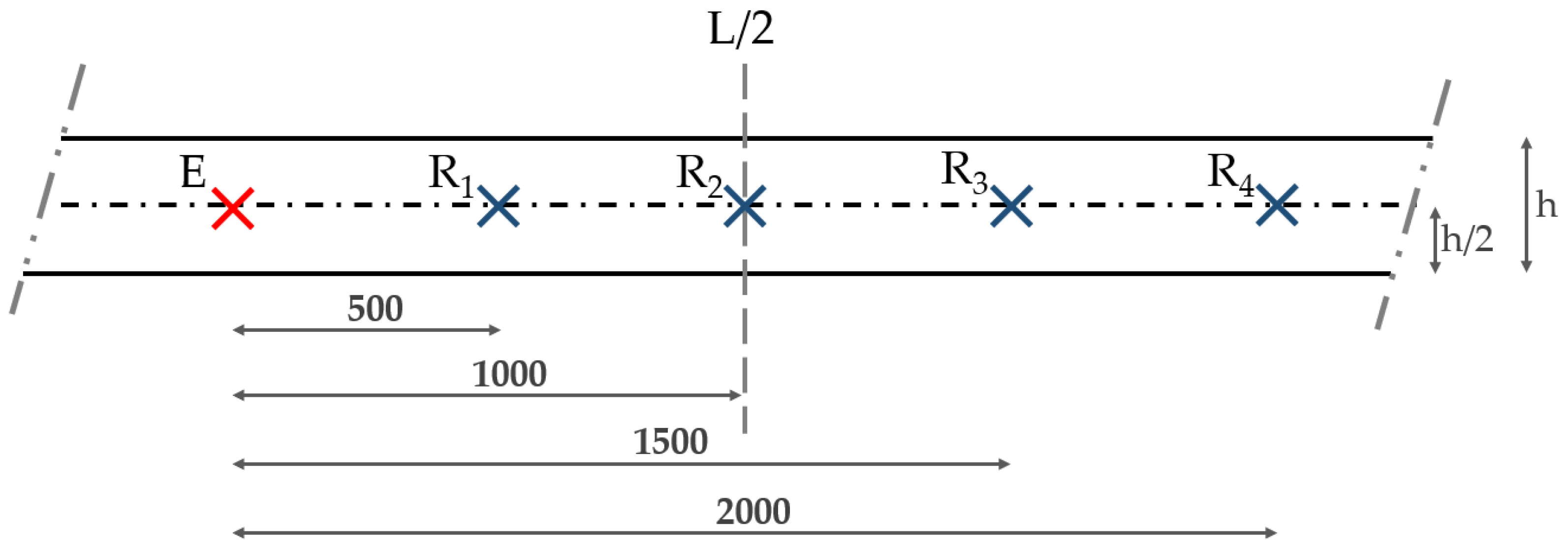
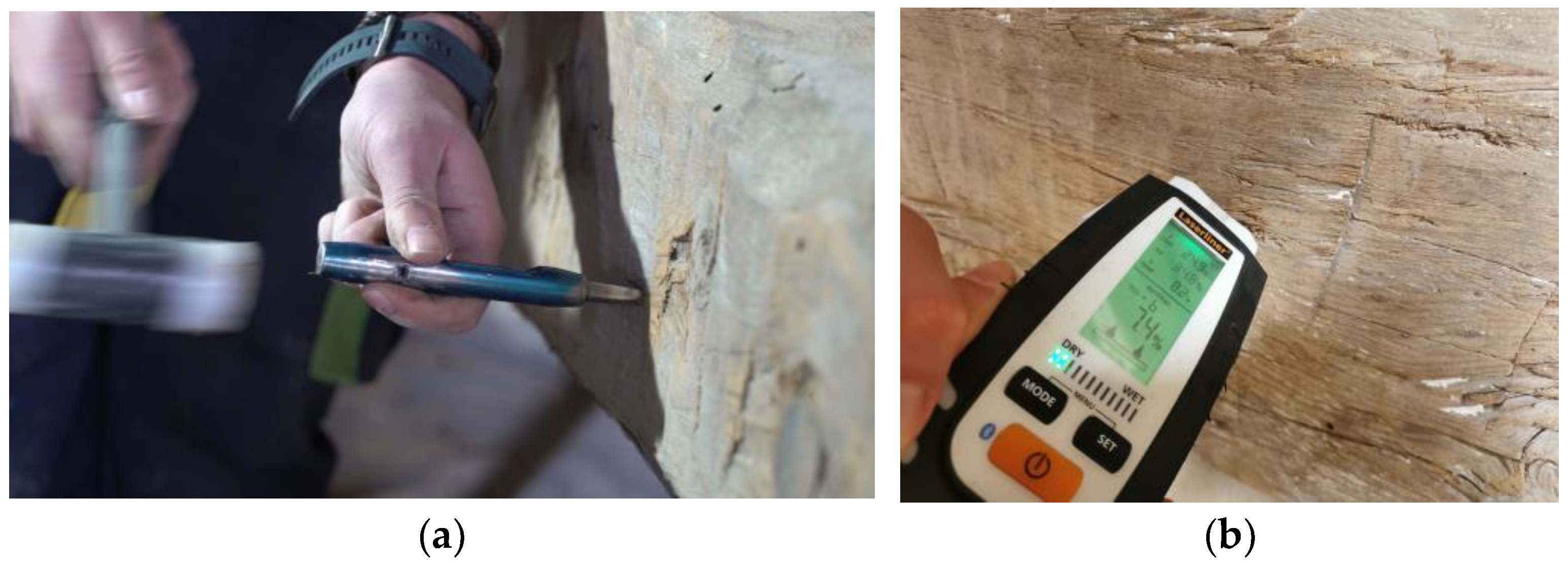
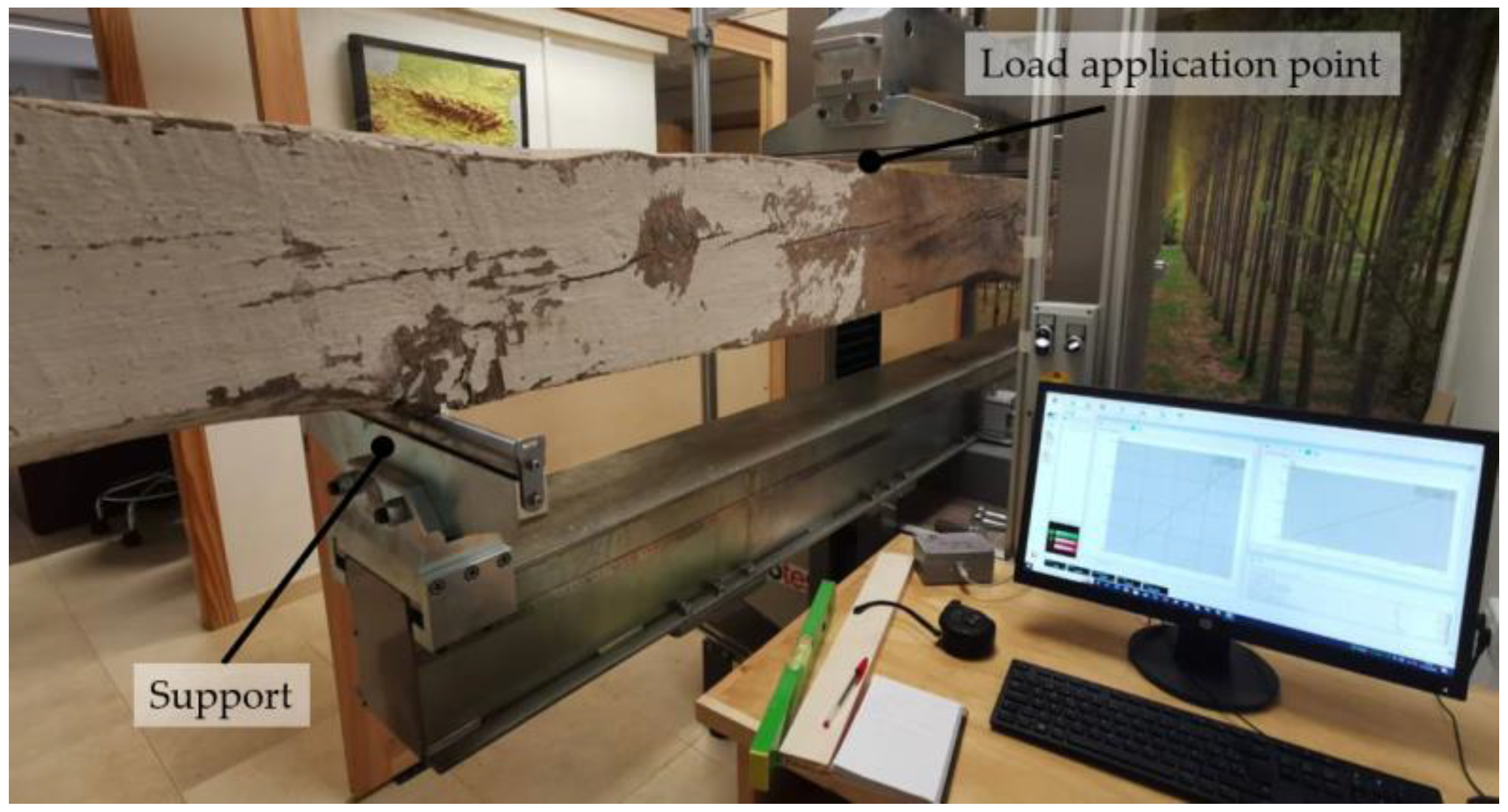

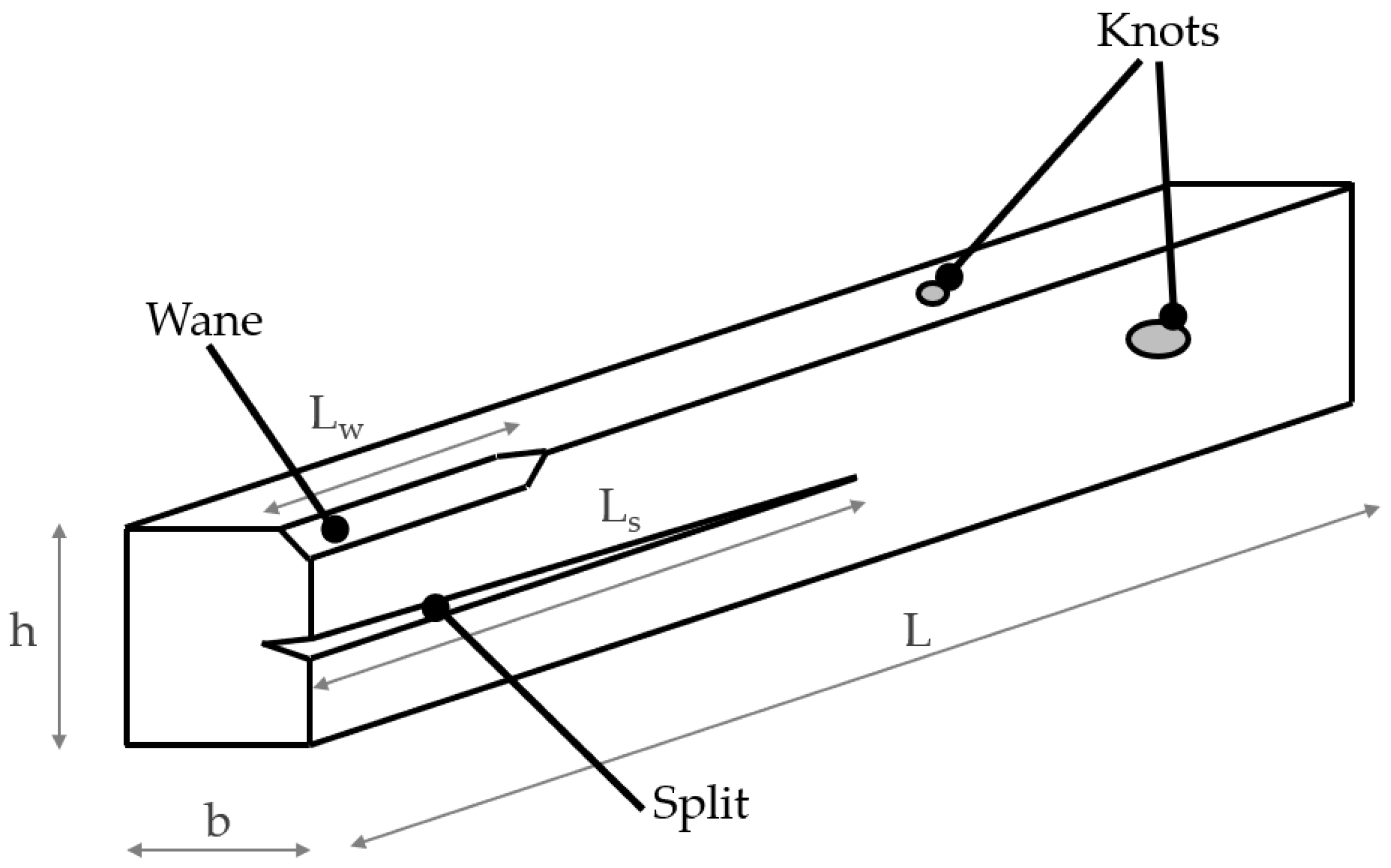
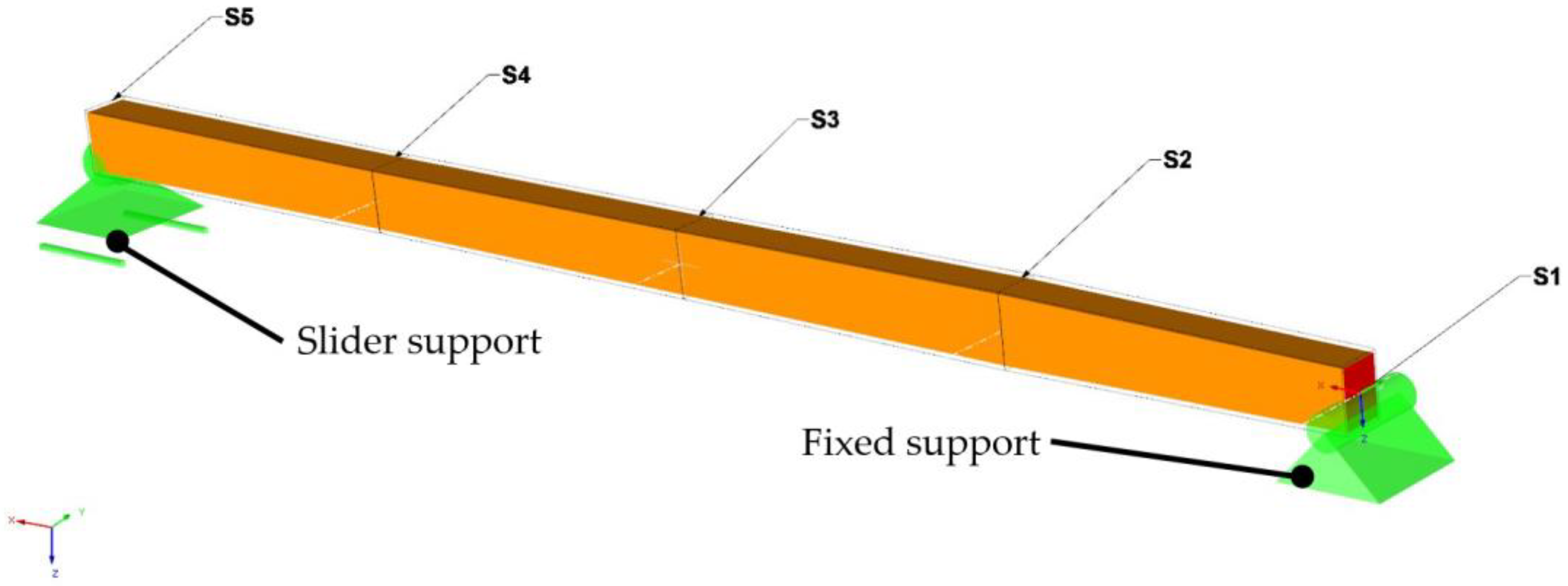

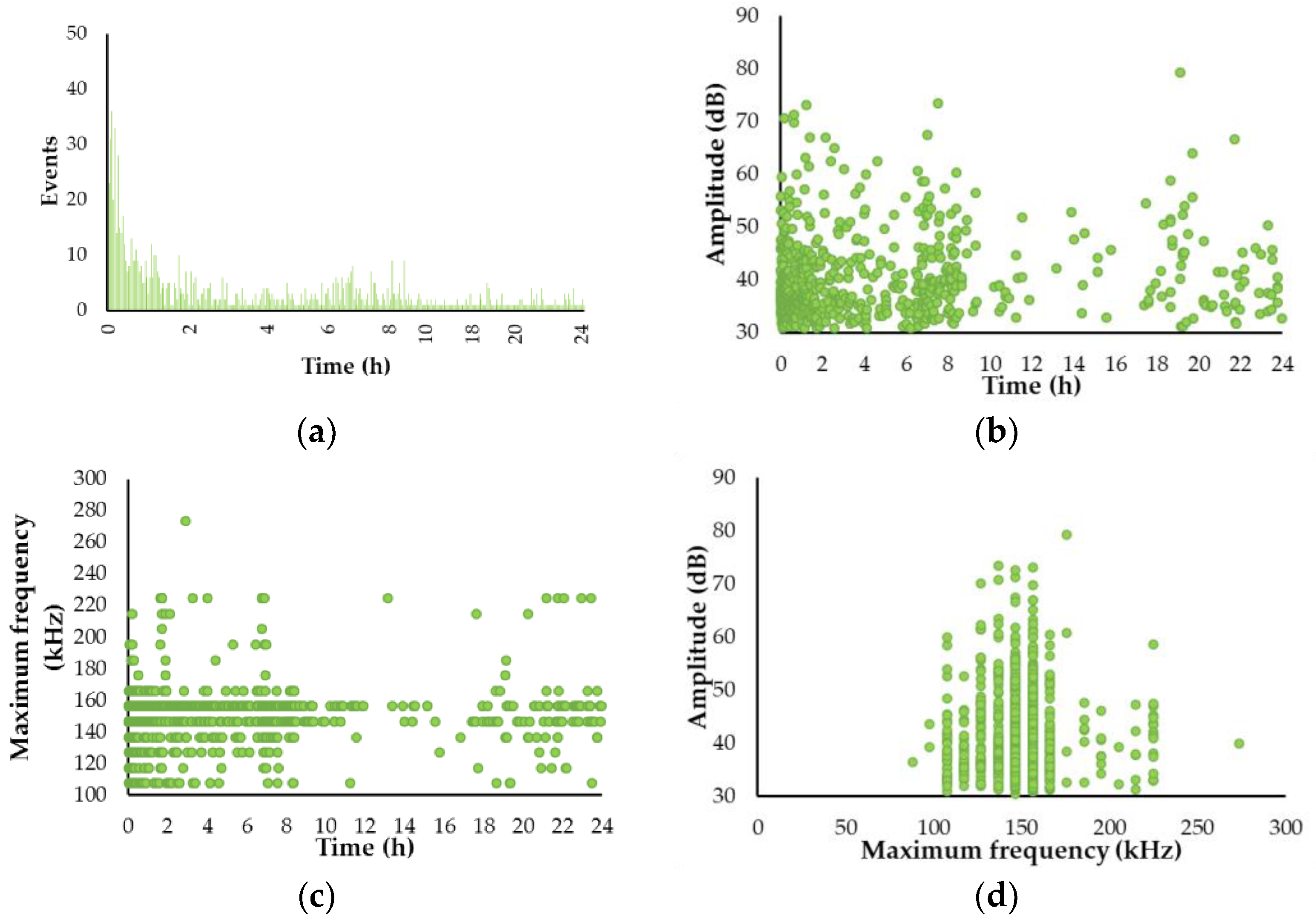




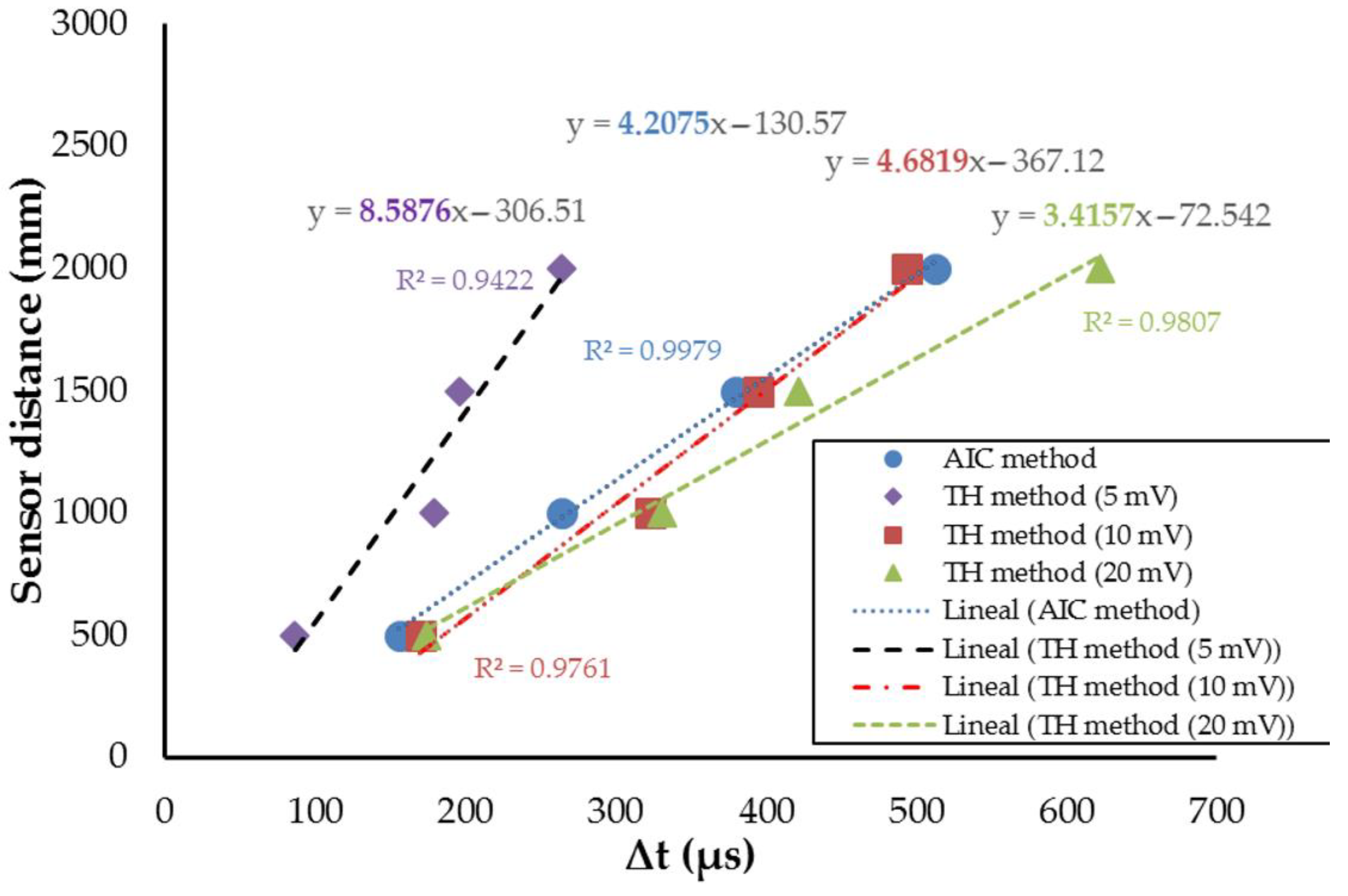
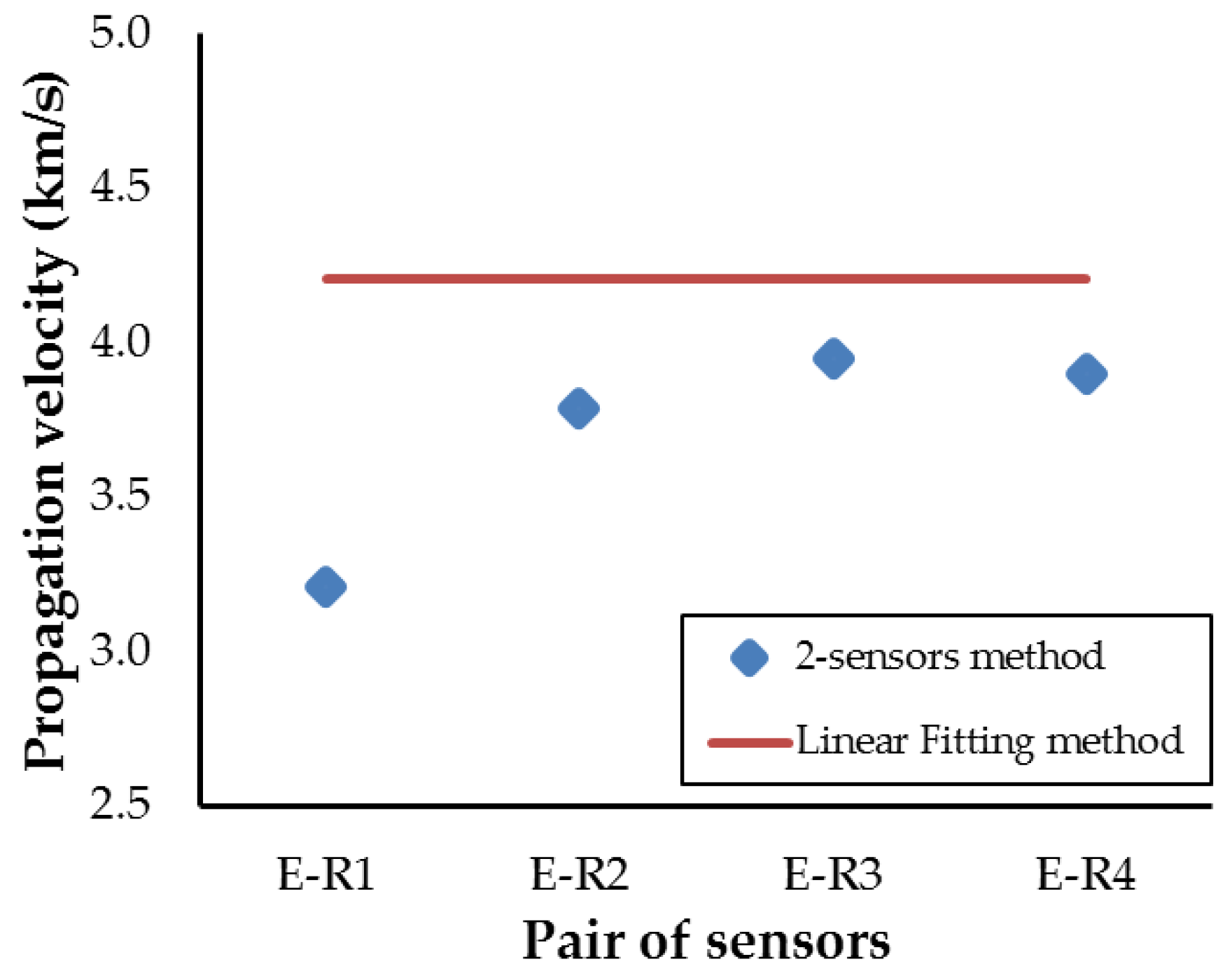
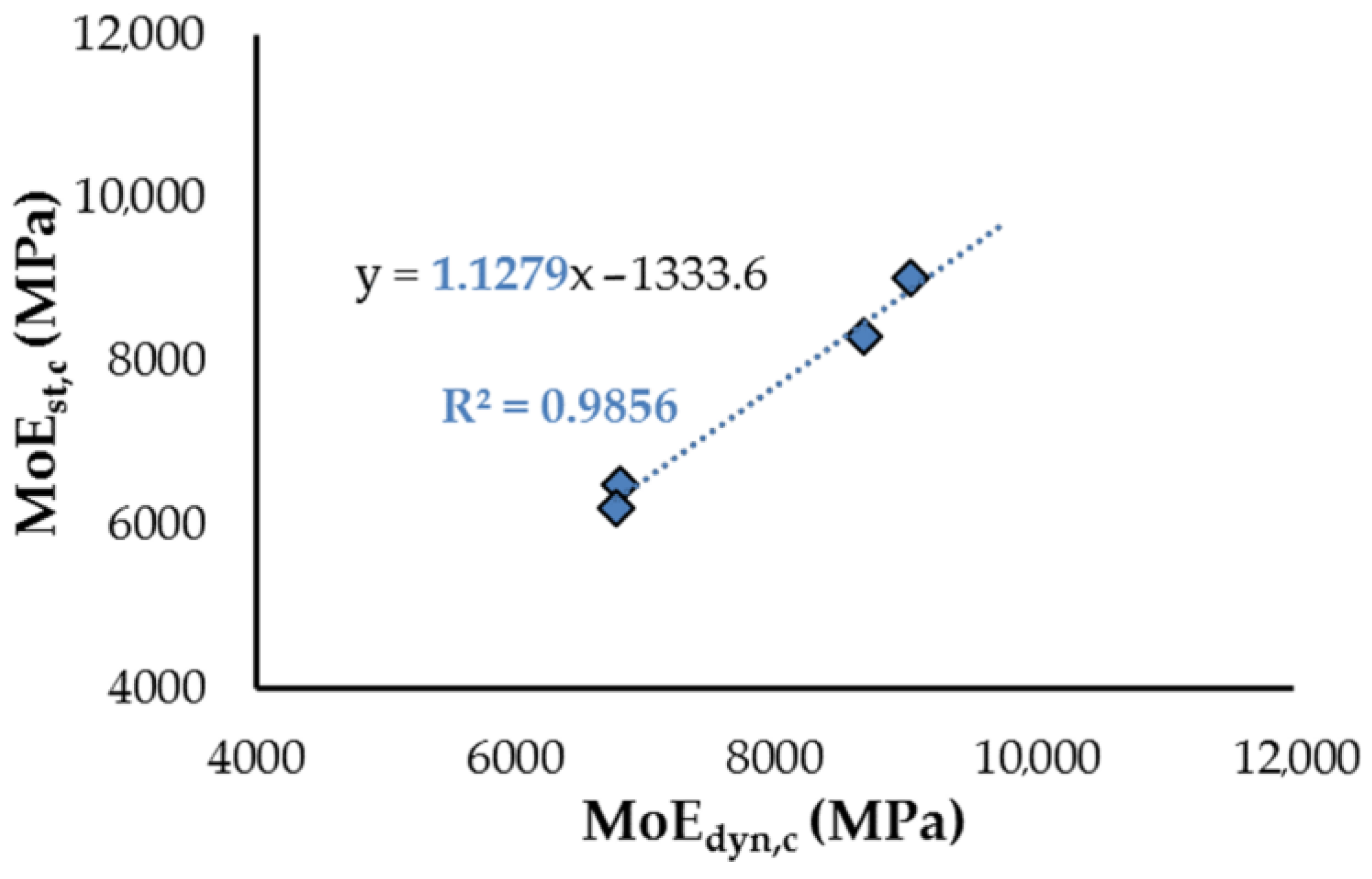
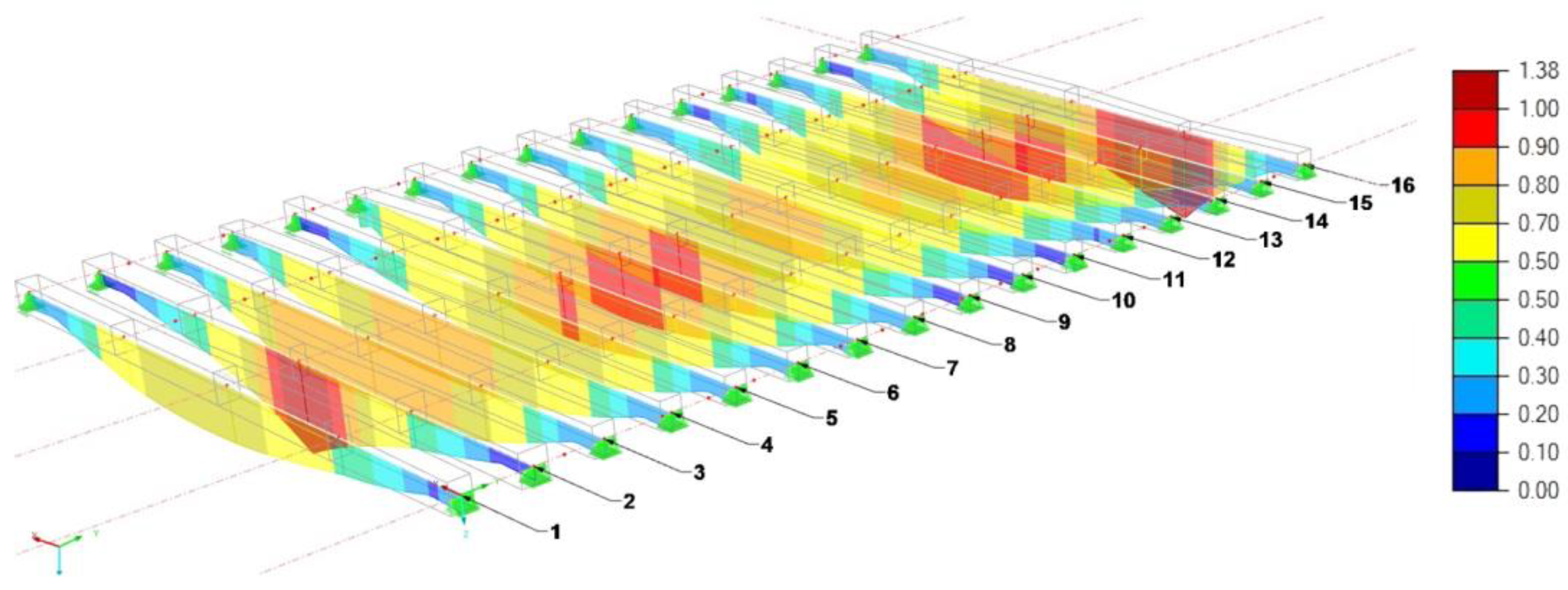
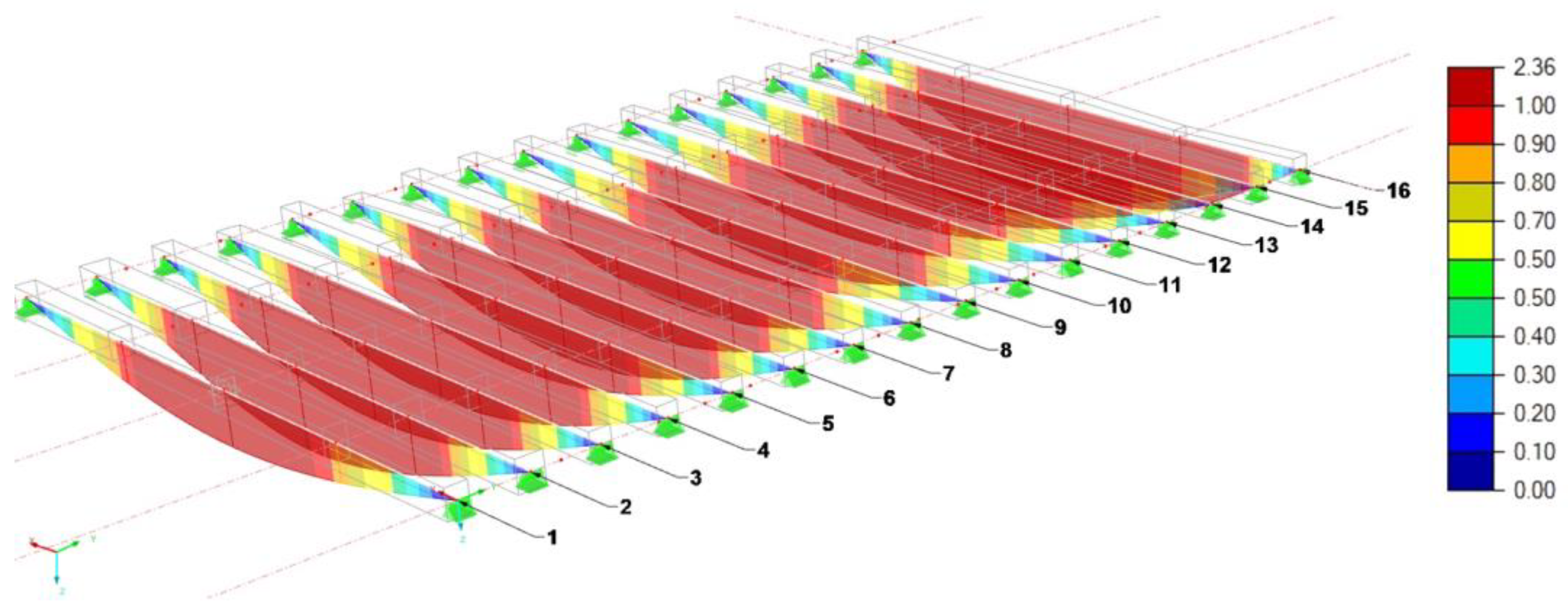
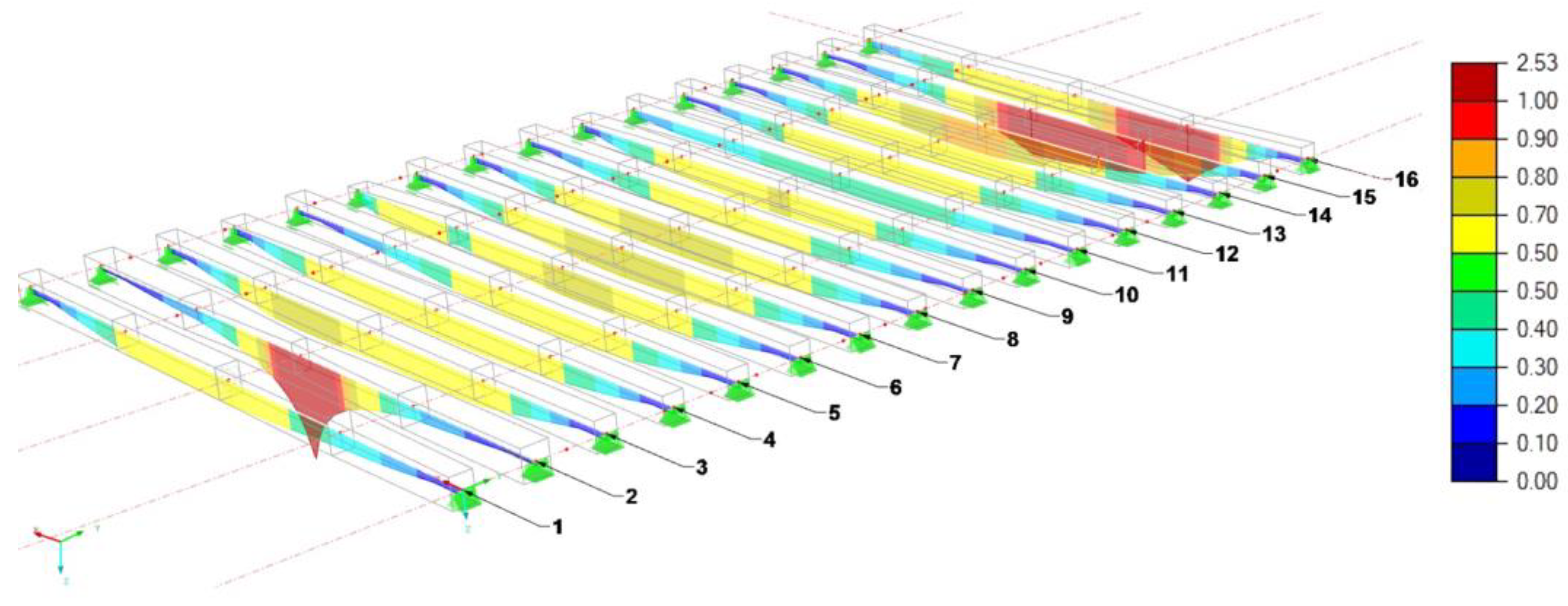
| Combination | Calculation State | |
|---|---|---|
| Ultimate limit state (ULS—fundamental) | ||
| CR1 | γq CC1 | Self weight |
| CR2 | γG CC1 + γQ CC2 | Self weight + live load |
| CR3 | γG CC1/p + γQ CC3 | Self weight + individual load |
| Serviceability limit state (SLS) | ||
| CR4 | kdef CC1/p + (1+ Ψ2 kdef) CC2 | Characteristic/rare |
| CR5 | CC2 | Characteristic/quasi-permanent |
| CR6 | (1+ kdef) CC1/p + Ψ2 (1+ kdef) CC2 | Quasi-permanent |
| Fire resistant (ULS—accidental) | ||
| CR7 | CC1 + 0.50 CC2 | Accidental—psi-1,1 |
| CR8 | CC1 + 0.50 CC3 | Accidental—psi-1,2 |
| Beam | Velocity (km/s) | Density (kg/m3) | MoEdyn (MPa) | Moisture Content (%) | MoEdyn,c (MPa) | Strength Grading |
|---|---|---|---|---|---|---|
| 1 | 4.21 | 531 | 9282 | 9.5 | 9050 | C18 |
| 2 | 3.68 | 524 | 7005 | 9.3 | 6816 | Rejection |
| 3 | 4.10 | 516 | 8549 | 9.2 | 8309 | C16 |
| 4 | 4.12 | 484 | 8066 | 8.9 | 7816 | C14 |
| 5 | 4.29 | 444 | 8068 | 9.3 | 7850 | C14 |
| 6 | 4.19 | 463 | 7999 | 8.8 | 7743 | C14 |
| 7 | 3.89 | 599 | 8943 | 9.5 | 8719 | C16 |
| 8 | 4.43 | 485 | 9360 | 8.7 | 9052 | C18 |
| 9 | 4.54 | 496 | 10,096 | 8.9 | 9783 | C20 |
| 10 | 3.93 | 554 | 8431 | 9.5 | 8220 | C16 |
| 11 | 3.94 | 493 | 7556 | 9.2 | 7344 | C14 |
| 12 | 4.67 | 446 | 9600 | 9.1 | 9321 | C18 |
| 13 | 3.98 | 534 | 8347 | 9.0 | 8096 | C16 |
| 14 | 4.12 | 536 | 8952 | 9.1 | 8692 | C16 |
| 15 | 4.03 | 437 | 6995 | 9.0 | 6785 | Rejection |
| 16 | 3.90 | 498 | 7484 | 9.3 | 7282 | C14 |
| Beam | MoEst,c (MPa) | MoEdyn,c (MPa) |
|---|---|---|
| 1 | 9015 | 9050 |
| 2 | 6494 | 6816 |
| 14 | 8300 | 8692 |
| 15 | 6208 | 6785 |
| Beam | Pathologies | Active Xylophages | Visual Grading | Main Cause of Rejection |
|---|---|---|---|---|
| 1 | Woodworm | Yes | Rejection | Wane |
| 2 | Reduced cross-section in beam center, woodworm, cracks, twist | Yes | Rejection | Wane |
| 3 | High humidity in beam head S1, woodworm, twist in beam head S1 | Yes | Rejection | Wane |
| 4 | High humidity, woodworm, crack in tensile crack (1400–1700 mm), twist (0–2500 mm) | Yes | Rejection | Knot Wane |
| 5 | Woodworm, crack in tensile knot (1400 mm) | Rejection | Wane | |
| 6 | Woodworm, high humidity in beam head S1, internal cavity, high reduced cross-section in beam head S5, deficient support in beam head S1 (170 mm) | Rejection | Knot Wane | |
| 7 | Woodworm, crack in tensile crack (4900 mm) | Rejection | Knot Wane | |
| 8 | Woodworm, twist in beam head S1 (0–2000 mm) | Rejection | Wane | |
| 9 | Woodworm, crack in tensile knot (5000 mm), high presence of knots in beam center | Rejection | Wane | |
| 10 | Woodworm, twist in beam head S1 (0–1850 mm), concentration of grouped knots in beam center (diameter = 110 mm) | Rejection | Wane | |
| 11 | Woodworm, high deflection, reduced cross-section in end of beam | Yes | Rejection | Wane |
| 12 | Woodworm, twist in beam head S5 | Rejection | Wane | |
| 13 | Woodworm, twist in beam head S1, large knots in tensile part of beam center, reduced cross-section in beam head S5 | Rejection | Wane | |
| 14 | Woodworm, slight twist (1700–5000 mm) | Rejection | Wane | |
| 15 | Woodworm | Rejection | Knot | |
| 16 | Woodworm, twist | Yes | Rejection | Knot Wane |
| Beam | ULS | SLS | Fire Resistance | |||||
|---|---|---|---|---|---|---|---|---|
| Integrity | Comfort | Appearance | ||||||
| CR1 | CR2 | CR3 | CR4 | CR5 | CR6 | CR7 | CR8 | |
| 1 | 0.37 | 0.78 | 0.48 | 1.26 | 0.72 | 0.90 | 0.64 | 0.46 |
| 2 | 0.62 | 1.24 | 0.46 | 1.88 | 1.04 | 1.38 | 2.53 | 1.44 |
| 3 | 0.43 | 0.86 | 0.31 | 1.78 | 1.00 | 1.27 | 0.73 | 0.40 |
| 4 | 0.41 | 0.85 | 0.30 | 1.84 | 1.04 | 1.31 | 0.68 | 0.38 |
| 5 | 0.38 | 0.80 | 0.50 | 1.49 | 0.84 | 1.06 | 0.66 | 0.48 |
| 6 | 0.43 | 0.91 | 0.32 | 1.92 | 1.09 | 1.37 | 0.74 | 0.40 |
| 7 | 0.47 | 0.94 | 0.35 | 1.72 | 0.95 | 1.27 | 0.78 | 0.45 |
| 8 | 0.43 | 0.91 | 0.32 | 1.68 | 0.95 | 1.19 | 0.74 | 0.41 |
| 9 | 0.38 | 0.78 | 0.29 | 1.22 | 0.68 | 0.89 | 0.60 | 0.34 |
| 10 | 0.43 | 0.65 | 0.32 | 1.63 | 0.90 | 1.19 | 0.70 | 0.40 |
| 11 | 0.32 | 0.64 | 0.24 | 1.26 | 0.70 | 0.92 | 0.47 | 0.27 |
| 12 | 0.38 | 0.81 | 0.29 | 1.35 | 0.76 | 0.96 | 0.64 | 0.35 |
| 13 | 0.41 | 0.83 | 0.31 | 1.57 | 0.87 | 1.15 | 0.66 | 0.38 |
| 14 | 0.49 | 1.00 | 0.36 | 1.84 | 1.03 | 1.33 | 0.84 | 0.47 |
| 15 | 0.44 | 0.95 | 0.33 | 1.88 | 1.07 | 1.31 | 0.99 | 0.54 |
| 16 | 0.65 | 1.38 | 0.48 | 2.36 | 1.34 | 1.66 | 1.62 | 0.88 |
| Beam | Visual Grading | Elastic Waves Grading | ULS (%) | SLS (%) | Fire Resistant (%) |
|---|---|---|---|---|---|
| 1 | Rejection | C18 | >90 | ||
| 2 | Rejection | Rejection | >90 | >90 | >90 |
| 3 | Rejection | C16 | >90 | ||
| 4 | Rejection | C14 | >90 | ||
| 5 | Rejection | C14 | >90 | ||
| 6 | Rejection | C14 | >90 | >90 | |
| 7 | Rejection | C16 | >90 | >90 | |
| 8 | Rejection | C18 | >90 | >90 | |
| 9 | Rejection | C20 | >90 | ||
| 10 | Rejection | C16 | >90 | ||
| 11 | Rejection | C14 | >90 | ||
| 12 | Rejection | C18 | >90 | ||
| 13 | Rejection | C16 | >90 | ||
| 14 | Rejection | C16 | >90 | >90 | >90 |
| 15 | Rejection | Rejection | >90 | >90 | >90 |
| 16 | Rejection | C14 | >90 | >90 |
| Number of Non-Passing Features Considered for Rejection | Rejected Beams | Number of Rejected Beams |
|---|---|---|
| ≥1 | 1–16 | 16 |
| ≥2 | 1–16 | 16 |
| ≥3 | 2, 6–8, 14–16 | 7 |
| ≥4 | 2, 15–16 | 3 |
| ≥5 | 2, 15 | 2 |
| Category | Number of Non-Passing Features | Beams |
|---|---|---|
| 5 | 5 | 2*, 15 |
| 4 | 4 | 16* |
| 3 | 3 | 6, 7, 8, 14 |
| 2 | 2 | 1*, 3*, 4*, 5, 9, 10, 11*, 12, 13 |
| 1 | 1 | - |
| 0 | 0 | - |
Publisher’s Note: MDPI stays neutral with regard to jurisdictional claims in published maps and institutional affiliations. |
© 2022 by the authors. Licensee MDPI, Basel, Switzerland. This article is an open access article distributed under the terms and conditions of the Creative Commons Attribution (CC BY) license (https://creativecommons.org/licenses/by/4.0/).
Share and Cite
Cruz, C.; Gaju, M.; Gallego, A.; Rescalvo, F.; Suarez, E. Non-Destructive Multi-Feature Analysis of a Historic Wooden Floor. Buildings 2022, 12, 2193. https://doi.org/10.3390/buildings12122193
Cruz C, Gaju M, Gallego A, Rescalvo F, Suarez E. Non-Destructive Multi-Feature Analysis of a Historic Wooden Floor. Buildings. 2022; 12(12):2193. https://doi.org/10.3390/buildings12122193
Chicago/Turabian StyleCruz, Carlos, Miquel Gaju, Antolino Gallego, Francisco Rescalvo, and Elisabet Suarez. 2022. "Non-Destructive Multi-Feature Analysis of a Historic Wooden Floor" Buildings 12, no. 12: 2193. https://doi.org/10.3390/buildings12122193





